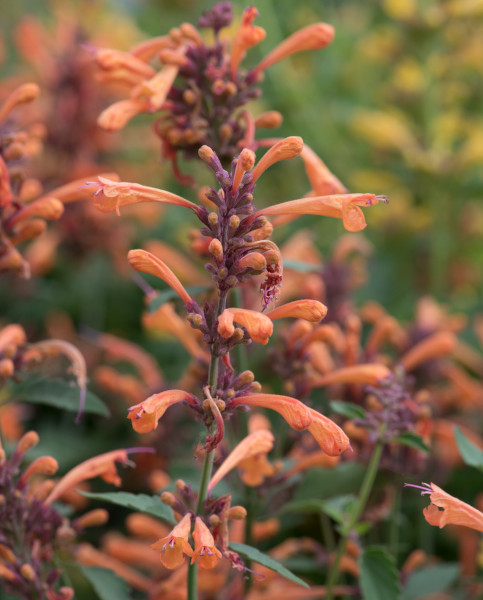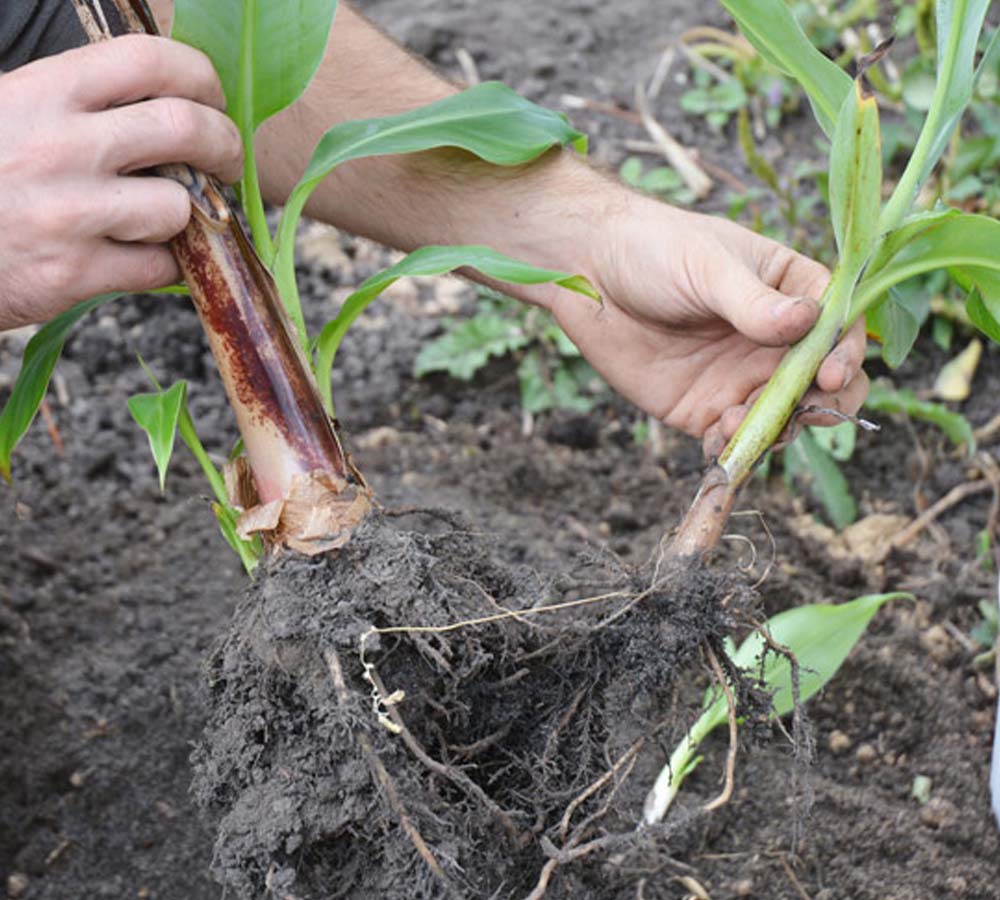How to grow Acacia Retinodes
Native to south-eastern areas of Australia, this fast-growing evergreen can be raised as a spreading shrub or a small tree. ‘Acacia retinodes’ blue-green foliage consists of lance-shaped, enlarged stalks, rather than true leaves (known as phyllodes). Short sprays of fluffy, lemon pom-pom flowers decorate the shrub throughout spring and summer and periodically during autumn. These nectar-rich blooms have a powdery, almond scent. The flowers are a magnet for bees and other pollinators. Commonly known as Mimosa or Swamp Wattle, this acacia will reach a mature height and spread of 8m x 4m after 10 to 20 years. ‘Acacia retinodes’ is also a winner of RHS’s Award of Garden Merit.

Key Information
Soil pH
Position
Hardiness


Where & when to plant Acacia Retinodes
In the UK, ‘Acacia retinodes’ will thrive in sunny gardens which benefit from a mild coastal environment or in urban areas in the south. This tender shrub is best located against a wall or in a courtyard setting which provides added shelter from colder weather. Until they have reached a reasonable size, young ‘Acacia retinodes’ should always be kept in a container in frost-free conditions. Once established, your shrub can be hardened to outdoor conditions, if winter temperatures do not dip below 1- 5°C. However, in any frosty weather, it is wise to protect your shrub with fleece and add a good layer of dried leaf mulch around the base. ‘Acacia retinodes’ prefer full sun with a south facing aspect. Well-drained, loamy or sandy soil which is acidic to neutral is ideal. This tender mimosa can be planted all year-round, as long as the ground is not waterlogged or frozen. In cooler regions, keep your acacia in a large container of loamy compost as a patio plant and transfer it indoors or to your conservatory for late autumn and winter.
How to plant Acacia Retinodes
- Water your plant well while it is still in its container.
- Remove the shrub from the pot and gently tease out any matted roots.
- Dig a planting hole the same depth and at least 3 or 4 times the width of the root mass.
- With a fork, loosen compacted soil on the base and sides of the hole. Mix a good quantity of compost into the soil in the hole.
- Young acacia plants require moist, soft soil, so fill the hole with water a couple of times and allow the water to drain away before planting.
- Place the shrub in the centre of the hole and fan out the roots. Back fill the hole with soil, taking care not to leave air pockets.
- Firm the soil gently and water to help settle the earth around the shrub.
- A mulch around the plant is a good idea, however, keep mulch 10cms away from the plant’s base to prevent rot.
- Stake your ‘Acacia retinodes’ firmly and keep the shrub well-watered when first planted.

What to plant with Acacia Retinodes
When planted in the garden, ‘Acacia retinodes’ willow-like foliage is nicely off-set by large-leafed ground cover or blooms held aloft on erect stems.
Alternatively, create a dramatic contrast by pairing your acacia’s yellow fuzzy blooms with larger flowerheads in blues, pinks or purples.
If you would like any further planting ideas or growing advice for your ‘Acacia retinodes’, please contact our friendly and knowledgeable Customer Care Team - we will be more than happy to help you.


How to care for Acacia Retinodes
Pruning and Deadheading
It is wise not to trim this plant in winter as acacia will not flower the following season if you do so. In general, these shrubs do not respond well to excessive pruning, so shape the tree while it is young and avoid too much pruning in maturity. ‘Acacia retinodes’ are best pruned after the main flush of flowering in summer.
Standard Tree
If you are growing your acacia as a standard tree, pruning is necessary to shape the tree during the first 5 years.
For the first 3 years, prune your young shrub in three clear divisions. Generally, leave the top third of the tree alone whilst removing any dead, diseased or badly placed growth. In the middle third of the tree, halve the length of the side shoots. Cut these stems just above a node which directs new growth in an outward direction. Finally, on the lower third of your shrub clear the main stem of all side growth.
In the 4th and 5th years, continue to clear the main stem (lower third) of all side growth until the length of the trunk fits your requirements. Always remove dead, diseased or badly placed stems on the top two thirds of the tree.
Once mature, only lightly prune your acacia, removing dead or diseased branches.
Multi-branched shrub
After the first year of growth, cut straight through the main stem of the young plant approximately 8cm from the ground to encourage the shrub to spread.
By the second year, multiple stems should have appeared. Cut all these shoots back to the base except for 3 or 4 sturdy stems which are nicely spaced.
In the third and fourth years of development, the main stems you retained should develop side shoots. When pruning, remove low hanging side shoots and any new stems growing directly from the base. If necessary, also thin out the side shoots in places where new growth is too crowded.
Once the shrub is mature, remove dead or damaged branches after flowering and thin out crowded growth. Side shoots can also be trimmed. Cut these 2 or 3 buds below the spent flowers.
Watering
‘Acacia retinodes’ are considered drought tolerant, however, your shrubs will require a weekly watering in summer until fully established. When planted in the garden, your mature ‘Acacia retinodes’ should only need watering every few weeks during hot weather and should be watered sparingly in the winter months. If your acacia is being kept in a container, then keep the soil moist rather than drenched, making sure there are adequate drainage holes to avoid water-logged soil.
During the growing season, monthly applications of liquid fertiliser are recommended.
Cold Protection
In frosty conditions, protect your young shrub by wintering container plants in a conservatory, or by covering immature garden shrubs with horticultural fleece.
Pests and Diseases
This variety is generally disease-free although it may be susceptible to Glasshouse red spider mite in greenhouses and conservatories.
How to propagate Acacia Retinodes
‘Acacia retinodes’ can be propagated from semi-hardwood cuttings (and seed). Below are instructions for taking semi-hardwood cuttings from your shrub.

Take your cuttings in the early morning in summer after the main flush of flowering. Select shoots which are healthy and free from disease. The shoots must have hardened yet still have a soft tip from the new summer’s growth. Cuttings with only small gaps between the leaf nodes are good choices. Using a knife or garden secateurs, cut diagonally across stems just below a leaf to take cuttings of 10-15 cm. Place the cuttings in a plastic bag and keep them in the shade. Pot them out within 12 hours. In extremely hot weather, you can also store cuttings in the fridge.

Trim your cuttings just below a lower leaf node and pinch out the tip, removing any flowers or buds. Next, remove all except 4 of the leaves on your cuttings. Be careful not to tear the bark while doing so. Trim down the remaining leaves a little to stimulate your cuttings’ growth hormones and reduce water loss. You can simply cut off half of each remaining leaf if you prefer. Dip the base of each cutting in hormone rooting powder and gently tap off any excess. Using a stick or pencil to make holes in the soil, plant your cuttings in pots with a mix of 50% cuttings compost and 50% sand or perlite. Firm the soil around the cutting gently and water the cuttings well.

Label your cuttings with the plant name and the date the cuttings were taken. Store the cuttings in a greenhouse or cover them with plastic bags. Initially, keep these young plants in good light away from direct sunlight and then gradually introduce the plants to gentle sunshine. The soil should be kept moist. Cuttings taken late summer or autumn are best raised in a propagator which provides bottom heat. Monitor root growth and pot on as and when required. Harden off the young plants gradually before planting them out.
Common ‘Acacia retinodes’ questions
What do you call the leaves on the ‘Acacia Retinodes’ if they are not true leaves?
These flattened leaf-like stalks are known as phyllodes.
What are acacias commonly called in Australia?
In Australia, these trees and shrubs are referred to as wattles. The Golden Wattle or ‘Acacia pycnantha’ is Australia’s national flower.
How long do acacias live?
In general, acacias have a lifespan of around 20 to 30 years.




